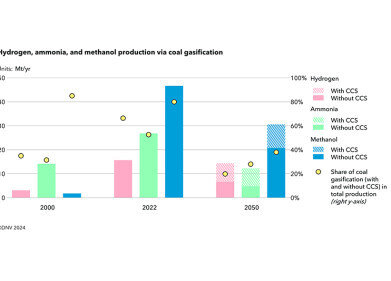Green Energy
Natural Hydrogen: A New Addition to the Energy Mix?
Apr 18 2013
IFP Energies Nouvelles (France) has become one of the first global research centres to actively investigate onshore natural hydrogen (H2) emissions after the discovery of offshore sources in the 1970s. Initial exploratory works have already shown that continuous onshore natural H2 emissions occur frequently. Now IFP Energies Nouvelles (IFPEN) is launching a new research project investigating the viability of industrial exploitation.
Currently, hydrogen (H2) is considered a carrier of energy rather than a source. It is not produced naturally like fossil energies, but is the product of converting other resources. The H2 used in industry is mainly produced by converting natural gas (CH4), which has the downside of emitting CO2. In the future, hydrogen produced through water electrolysis is expected to be used to store energy as a way of compensating for solar or wind power's intermittent output.
However, growing evidence is pointing to the existence of substantial, natural emissions of hydrogen. This forces a change of paradigm. On top of being a carrier of energy, hydrogen could also be a source of energy, like fossil energies, and its combustion would emit water (H2O) instead of CO2. While "natural" hydrogen does indeed exist and can be qualified as a clean source of natural energy, the question now being asked is whether it is sustainable. This is currently at the very heart of IFPEN's research.
Natural emanations of hydrogen were first discovered along mid-ocean ridges on the seabed (the so-called "black smokers" and "white smokers"). In this environment, volcanic systems create hydrothermal circulation, bringing together sea water and peridotites - highly reduced rocks from the Earth's mantle - at high temperatures. The peridotites oxidise upon contact with the sea water, and the reduction produces hydrogen. Unfortunately, these "smokers", are located at deep sea level, far from the coasts, and exploiting them is not economically viable.
IFPEN has therefore focused its research on more accessible, onshore sources of H2, which have been observed in two geological settings: terrestrial mountain ranges containing peridotites, where specific tectonics expose the mantle-derived rocks to alteration by meteoric water; intracontinental regions (intraplate regions) and in particular in the oldest parts (Precambrian cratons) located at their centre.
While scientific literature makes occasional reference to these hydrogen emanations, until now they have never been explored in detail.
IFPEN's initial research proved the existence of major local flows of H2 in major peridotite mountain ranges all over the world. More importantly, it demonstrated hydrogen flows were a common feature in intraplate regions. Despite the flows being sparse on most sites, substantial local accumulations were identified in some areas. The various natural fluids studied can present up to 80% of H2. It is often associated with methane, occasionally nitrogen and, in some places, economically viable quantities of helium (at a time when demand for this rare gas with numerous high-tech applications are stretching global supplies to their limit).
IFPEN is examining two possible explanations of onshore hydrogen:
- oxidisation of rocks rich in reduced iron by water;
- continuous outgassing by the Earth, which would dramatically alter conceptions of the chemical composition of terrestrial planets' interior structure.
IFPEN, a pioneer in onshore natural hydrogen research, is set to continue its work as part of a new project to assess the technical and economic viability of industrial natural H2 production. Particular interest will be paid to cratons, which cover very large areas, and may prove highly promising for production.
If natural hydrogen exploitation were indeed possible, it could constitute a new source of sustainable energy - as production seems to be a continuous phenomenon linked to the Earth's tectonics - as well as being clean and environmentally friendly and evenly distributed between the continents. Large-scale industrial production, however, remains a long way off, and further research efforts are needed to determine if this is possible.
Events
May 05 2024 Seville, Spain
May 13 2024 Munich, Germany
May 23 2024 Beijing, China
May 23 2024 Beijing, China
Jun 10 2024 Algiers, Algeria














